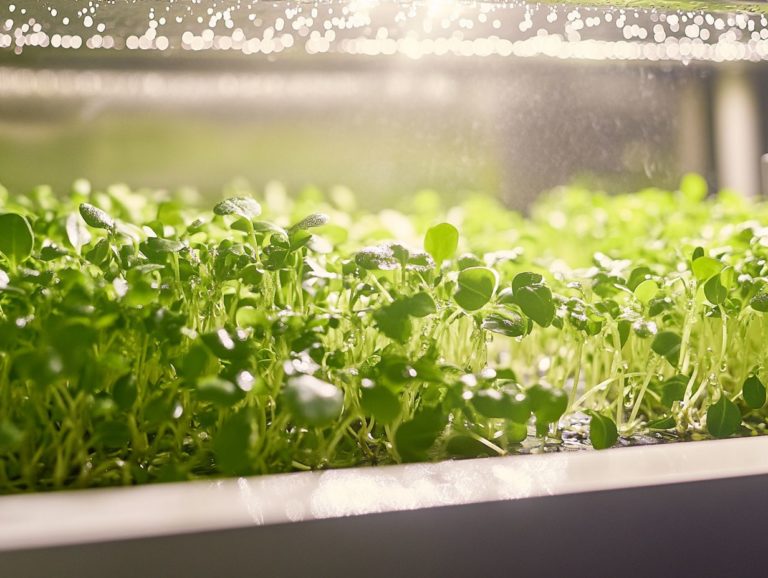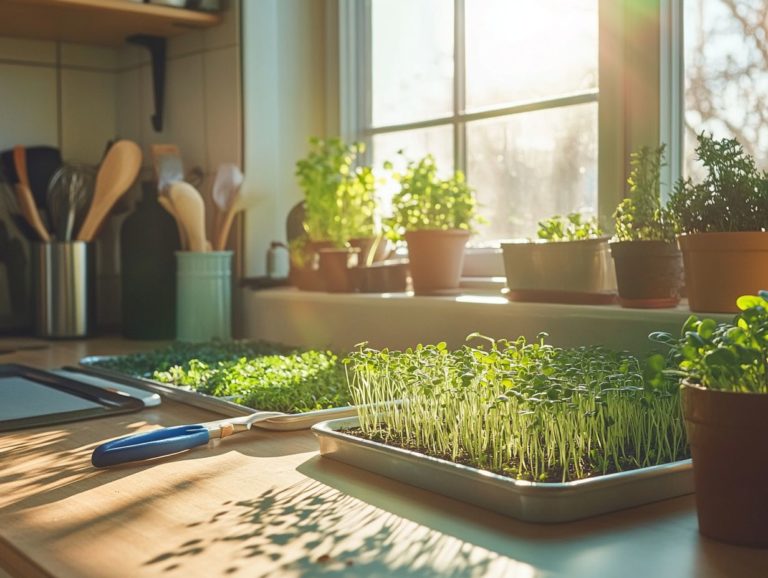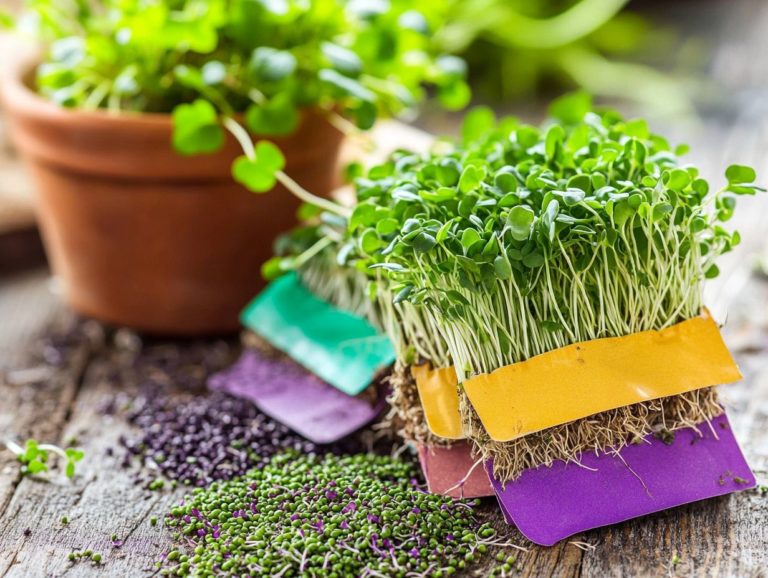The Benefits of Indoor Microgreen Growing
Microgreens are remarkably small, nutrient-dense plants. They are often referred to as nutrient-rich plants that bring exceptional flavor and health benefits to your plate. This article delves into the vibrant world of these greens, covering everything from their definition and various types to the advantages of growing plants inside your home or building.
Discover their impressive nutritional value and follow practical steps to kickstart your indoor garden. You’ll also find expert tips for nurturing microgreens to perfection. Get inspired with creative ways to enhance your meals with a fresh twist featuring these aromatic flavors.
Jump in and discover the amazing benefits of microgreens today!
Contents
Key Takeaways:
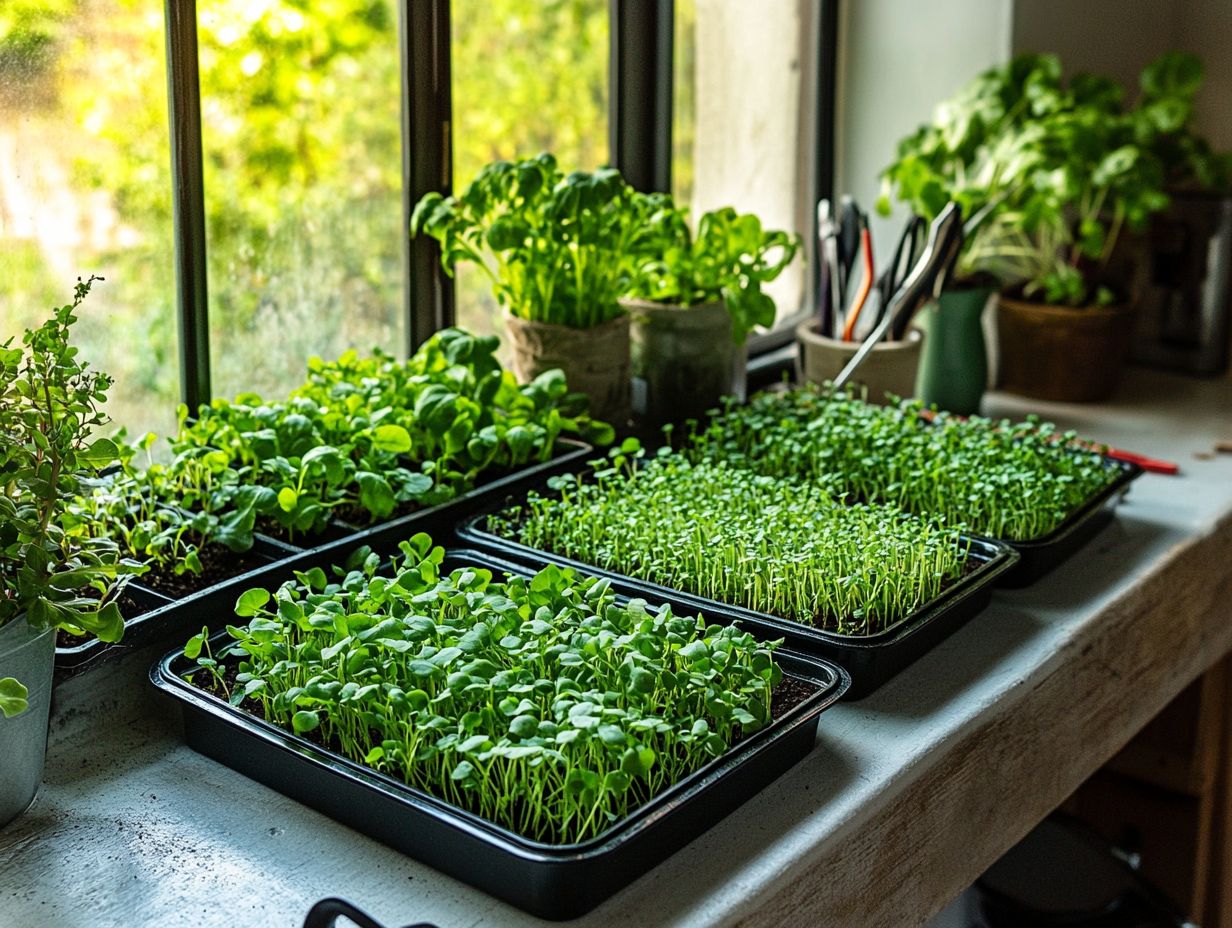
- Growing microgreens at home offers numerous benefits, including convenience, control over growing conditions, and year-round cultivation of fresh, nutritious greens.
- Microgreens are nutrient-rich and may help improve health, containing high levels of vitamins, minerals, and plant compounds.
- With just a few simple supplies and steps, anyone can start growing microgreens indoors. These versatile greens can add flavor, texture, and nutrients to meals and recipes.
What are Microgreens?
Microgreens are young edible plants that you can harvest at an early stage of growth. They are celebrated for their vibrant colors, aromatic flavors, and exceptional nutritional benefits.
These small but powerful vegetables include varieties like broccoli, kale, radish, arugula, and sunflower. Each type is packed with nutrients such as vitamin C, iron, magnesium, potassium, and zinc.
Their popularity has skyrocketed among health-conscious individuals. They are rich in vitamins and antioxidants, making them organic and pesticide-free. This makes them an ideal ingredient for salads and smoothies, promoting indoor gardens for both cooking uses and health benefits.
Definition and Types
Microgreens are those young edible plants you spot just after the first true leaves emerge. They come in a delightful variety, each boasting its own unique flavors and impressive nutritional profiles.
Growing plants inside your home or building microgreens is a straightforward process. It involves planting seeds in shallow trays, ensuring they receive adequate sunlight and moisture, and maintaining a specific temperature range.
This entire growth journey typically spans just a few weeks. This makes it an appealing choice for both home gardeners and commercial farmers.
Among the diverse varieties, broccoli microgreens stand out with their slightly bitter flavor. They also pack a punch with antioxidants.
- Kale brings a robust flavor to the table.
- Radish microgreens deliver a peppery kick that can elevate any dish.
- Arugula adds a distinct, spicy zest, making it perfect for salads.
- Sunflower microgreens offer a nutty flavor, ideal for enhancing sandwiches and wraps.
Each type thrives under specific conditions. Sunlight and quality soil play crucial roles in their development, underscoring their importance in cooking uses and nutritional value.
Why Grow Microgreens Indoors?
Growing microgreens indoors offers a multitude of benefits. This practice is an ideal choice for health-conscious individuals and urban gardeners alike.
Their compact size and ability to flourish year-round mean you can cultivate them even in the tightest spaces. This provides a sustainable and cost-effective source of fresh produce.
By using grow lights, you can effortlessly create the perfect conditions for growth. This ensures that these nutrient-rich plants are always at your fingertips, no matter the season.
This not only elevates your culinary experience but also enhances your dietary habits. You can enjoy fresh, vibrant flavors every day.
Advantages of Indoor Growing
Indoor growing offers remarkable advantages for microgreens. It creates the perfect environment for these young edible plants to thrive all year long.
A controlled climate reduces risks from pests and diseases. Your plants will remain healthier and more robust.
Urban gardeners can easily cultivate fresh greens at home, regardless of the weather.
Using grow lights boosts growth rates and increases yields. These lights mimic sunlight, providing the intensity needed for photosynthesis.
This setup maximizes productivity. You can tailor conditions for specific microgreen varieties, making year-round gardening simple.
Health Benefits of Microgreens

Microgreens are celebrated as nutritional powerhouses, brimming with an impressive array of health benefits. They have the potential to combat Alzheimer s disease, heart disease, and diabetes, enhancing any diet.
These young edible plants are rich in vitamins and antioxidants, offering a concentrated source of essential nutrients that may aid in combatting various health issues.
Their higher levels of plant compounds play a significant role in overall wellness and vitality. They are the ideal choice for those who prioritize health and seek to enrich their meals with nutrient-dense options.
Nutritional Value and Potential Health Effects
The nutritional value of microgreens is impressively high, providing a rich array of vitamins and minerals essential for your health.
These tiny powerhouses have more nutrients than mature vegetables, making them a favorite among health enthusiasts across California. For instance, broccoli microgreens are renowned for their wealth of glucosinolates, which are natural compounds found in some vegetables that may help fight cancer. Additionally, sunflower microgreens deliver a generous dose of vitamin E, an antioxidant that supports your skin health. To learn more about their benefits, check out the health benefits of microgreens explained.
Radish microgreens are another star, packed with vitamin C to boost your immune function and iron, which is crucial for maintaining your energy levels. Regularly incorporating these potent greens into your diet can enhance your nutritional intake and may also lead to reduced inflammation and improved overall well-being.
This offers an exciting opportunity for anyone looking to elevate their health through natural foods.
How to Get Started with Indoor Microgreen Growing
Embarking on the journey of growing microgreens at home is an exciting adventure! It gives you the power to cultivate your very own indoor garden with minimal effort and resources.
By adhering to a straightforward guide, you can effortlessly nurture these young edible plants in your space, using basic supplies and techniques that guarantee successful growth and harvesting.
From choosing the ideal seeds to creating the perfect environment, you’ll find this journey rewarding and great for your health!
Supplies and Steps
Gather the right supplies now to kickstart your journey! To successfully grow microgreens at home, it’s essential to follow a clear step-by-step guide. With just a few basic items, you can embark on a rewarding journey of cultivating nutritious greens right in your kitchen.
- Start by securing high-quality seed varieties; these are crucial for healthy growth.
- A seedling tray is necessary. It provides proper drainage and space for your plants to thrive.
- Next, choose a well-mixed potting soil, a special mix that helps plants grow, which retains moisture while allowing for proper air exchange, contributing to robust root development.
- A spray bottle is also important for gentle watering, helping to avoid the disturbance of those delicate seeds.
- And don’t overlook a reliable light source, whether it’s natural sunlight or grow lights, to ensure your microgreens develop strong and flavorful leaves.
Once you’ve gathered your supplies, it’s time to prepare the soil. Fill your tray evenly, ensuring proper drainage, and create the perfect bed for your seeds to flourish. For those interested in maximizing their yield, exploring the benefits of multi-layer microgreen growing can provide additional insights.
Caring for Your Microgreens
Caring for your microgreens requires a few essential tips that guarantee optimal growth and a successful harvest, enabling you to fully savor their rich flavor and nutritional benefits.
Tips for Optimal Growth and Harvesting
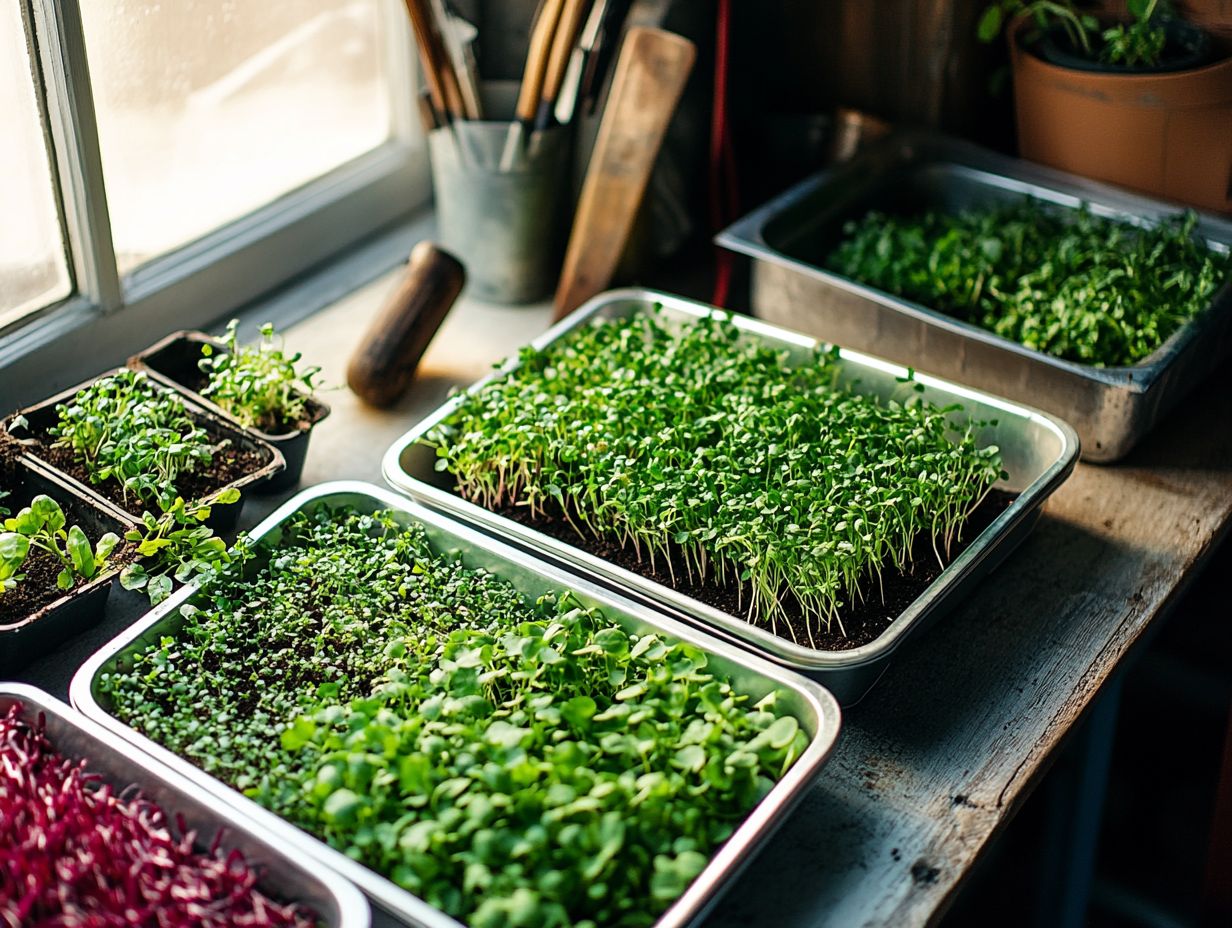
To achieve great growth and a successful harvest of microgreens, implementing specific strategies will significantly elevate your indoor gardening experience.
It’s crucial for you to maintain the right balance when it comes to watering to ensure your microgreens remain moist but avoid the risk of rot. Ensure the seedlings remain moist but not waterlogged, as too much moisture can lead to rot.
Enough light is equally essential. Position your microgreens near a south-facing window or utilize grow lights for about 12-16 hours each day to support their healthy development.
For pest management, make it a habit to regularly inspect your microgreens for any signs of insects. Applying organic solutions, like neem oil, can effectively keep them pest-free.
For harvesting, do so gently with sanitized scissors, snipping the greens just above the soil line. This method preserves the integrity of the plant and encourages quicker regrowth for future harvests.
Creative Ways to Use Microgreens
Microgreens present a wealth of culinary possibilities that can elevate your dishes and enrich your diet with vibrant flavors and essential nutrients. They serve as a versatile addition, enhancing any recipe you choose to explore.
Incorporating Them into Meals and Recipes
Incorporating microgreens into your meals and recipes can truly enhance both the flavor and nutritional value of your dishes. These tiny, vibrant greens are not just packed with vitamins and antioxidants; they also bring a delightful crunch and a range of taste profiles that can elevate any plate.
For a fresh salad, consider mixing arugula and radish microgreens with cherry tomatoes, all tossed in a light vinaigrette. If you re blending smoothies, a handful of pea shoots can add a subtle sweetness along with an impressive nutrient boost.
Looking for a unique twist? Try adding sunflower microgreens to your next sandwich or wrap for an extra layer of texture.
With their remarkable versatility, microgreens can seamlessly find their way into breakfast omelets, grain bowls, and even as a garnish for soups. The possibilities are boundless, proving there’s no limit to how you can use them in your kitchen.
Frequently Asked Questions
What are microgreens?
Microgreens are young vegetable plants that are harvested after just a few weeks of growth. They are smaller than baby greens, but larger than sprouts, and are known for their intense flavor and high nutrient content.
Excited to start? Gather your supplies and discover the science behind microgreen growth as you see the magic unfold in your kitchen!
Why Should I Consider Growing Microgreens Indoors?
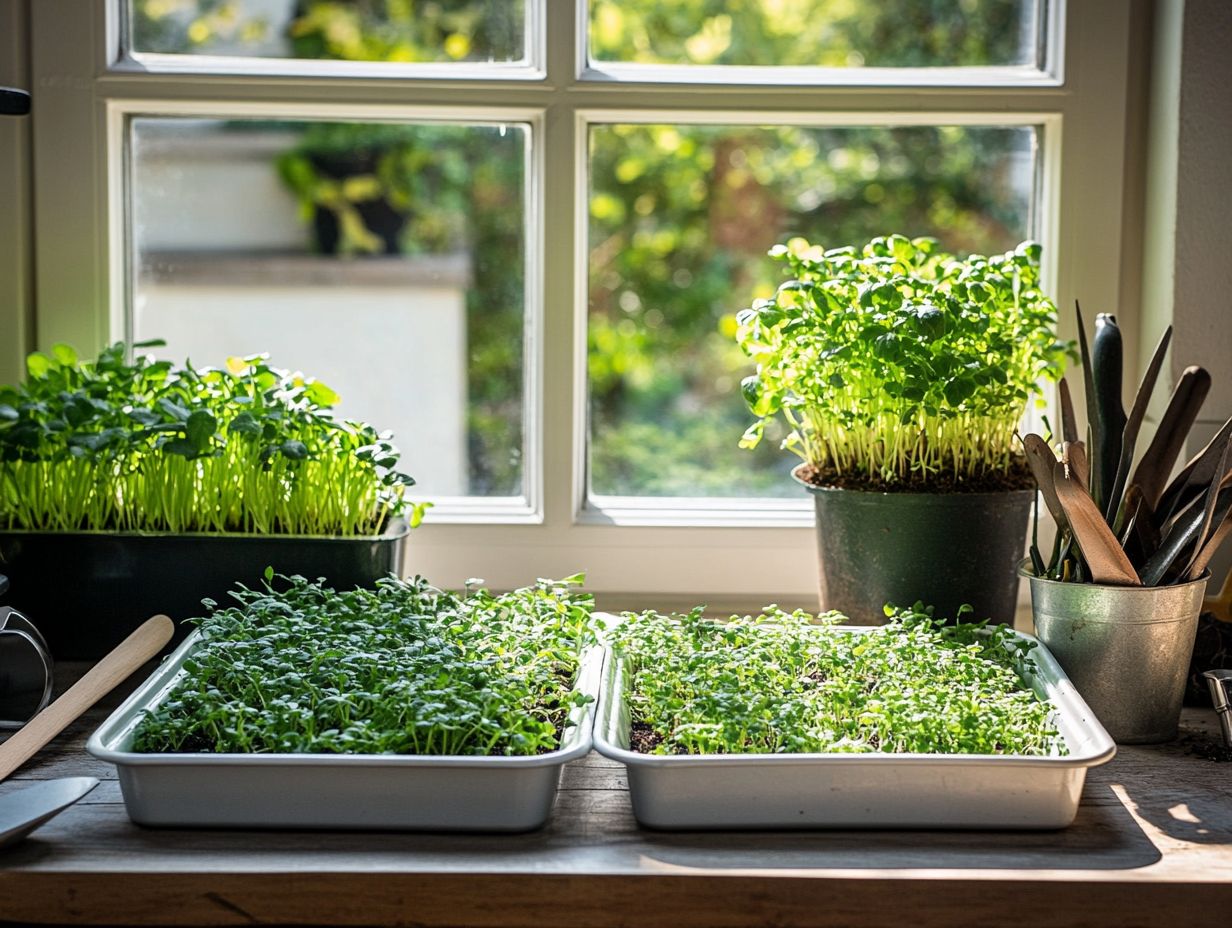
Growing microgreens indoors means fresh, delicious, and nutrient-packed greens all year. You can save money on produce and lower your carbon footprint.
What Are the Benefits of Growing Microgreens Indoors?
Microgreens are packed with nutrients and grow quickly and easily. They can also enhance the flavor and appearance of your meals.
They require minimal space, water, and maintenance. This makes them perfect for small living spaces.
What Types of Microgreens Can I Grow Indoors?
You can grow many types of microgreens indoors. Popular choices include broccoli, alfalfa, wheatgrass, and radish.
Feel free to experiment with unique varieties like amaranth, sunflower, and pea shoots!
Do I Need Any Special Equipment to Grow Microgreens Indoors?
You don t need fancy tools to grow microgreens. A windowsill, potting soil, and a spray bottle for misting will work just fine!
What Are Some Creative Ways to Use Microgreens in Meals?
Get creative! Microgreens can transform your meals in so many delicious ways. Use them as toppings for sandwiches or salads.
Mix them into omelets, smoothies, or use them as garnishes for soups and main dishes. They add a burst of flavor, texture, and nutrition!


